Introduction
At the heart of contemporary architecture and interior design, industrial lighting isn’t just a source of light; it’s a critical component that sets tone, creates atmosphere, and transforms spaces into immersive experiences. This approach, which once prioritized function over form in workplaces and factories, is now reinvented to bring a combination of raw aesthetics and minimalist elegance to homes, offices, and commercial spaces. This article takes a deep dive into the art of industrial lighting, exploring how innovative ideas are redefining environments and how you can apply these concepts to revitalize your own space.
History of Industrial Lighting
Industrial lighting began as a practical solution for illuminating large factories and warehouses during the Industrial Revolution. Using rugged materials and designs that emphasized durability and functionality, these fixtures were built to withstand harsh environments. However, as design trends evolved, these utilitarian pieces found new purpose. Designers and homeowners began to appreciate their unfinished appearance and ruggedness as a desirable contrast to polished interiors, giving rise to a new aesthetic that balances industrial history with modern comfort.
Fundamentals of Industrial Lighting Design
Industrial lighting design is characterized by its simplicity, use of raw materials such as metal, glass, and wood, and a look that suggests durability and strength. These elements combine to create an aesthetic that is both functional and visually striking. Lighting is not just a tool for seeing; it is an integral part of the design of a space, influencing how it is perceived and experienced.
Current Trends in Industrial Lighting
Today, industrial lighting is at the forefront of technology and design. Highly energy-efficient LED luminaires are replacing old incandescent bulbs, while smart lighting solutions enable unprecedented control and customization. Designers are increasingly integrating lighting into the architecture of the space, creating solutions that are as much a design feature as a source of light.
Case Studies in Industrial Lighting
The theory behind industrial lighting is fascinating, but it’s in practice that it really comes to life. Below, we’ll explore case studies where industrial lighting not only served a functional role, but also served as a key component in reinventing a space.
A. Industrial Chic Restaurant
In a vibrant city, a former warehouse has been transformed into a standout restaurant. The key to its welcoming ambiance is the lighting: metal pendant lights in shades of copper and bronze, suspended at varying heights, create a warm, ambient light that invites diners to sit back and enjoy the culinary experience. The lighting was strategically placed to highlight the textures of the brick walls and contemporary artwork, proving that industrial lighting can be as artistic as it is practical.
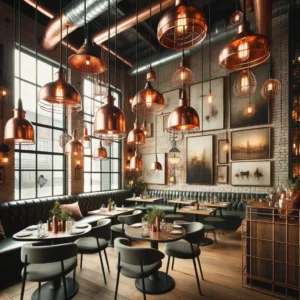
B. Transforming a Loft
An industrial-style loft can feel cold and impersonal, but not when lighting is used to define different areas and create visual flow. One innovative designer used a series of adjustable LED track lights to demarcate the living, dining and work spaces, providing flexibility to change the layout and intensity as needed. The use of exposed filament bulbs offers a nod to the space’s industrial heritage, while providing a soft, welcoming light.
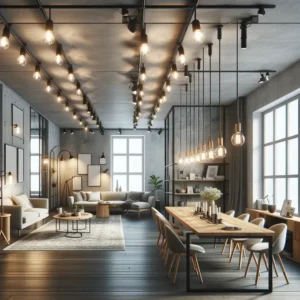
C. Modern Coworking Space
Coworking spaces require functional yet inspiring lighting to meet the diverse needs of their employees. In a converted industrial building, the lighting scheme uses a combination of vintage-style pendant lights and modern LED task lighting, offering both a nod to the building’s history and the modernity needed for productivity. The lighting is designed to be adaptable, with movable fixtures that can be adjusted as teams change and the space evolves.
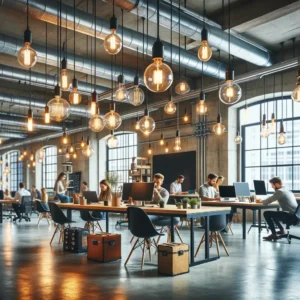
D. Contemporary Art Gallery
Art gallery lighting needs to be versatile to accentuate a variety of art forms. One gallery has taken advantage of industrial design to create a lighting system that is both functional and part of the exhibition. Track lights, with their industrial look and ability to be reoriented and dimmed, allow the direction of the light to be changed to highlight different pieces, while the lighting itself becomes a point of visual interest.
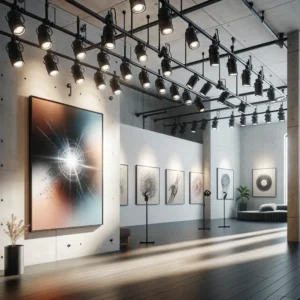
E. Renovation of a Boutique Hotel
A boutique hotel with an industrial theme can face the challenge of feeling cozy and luxurious at the same time. Using custom industrial chandeliers that combine iron and glass, the lighting creates a dramatic statement and invites guests into a space that is both refined and raw. Soft lighting from light fixtures throughout the hallways and guest rooms complements the aesthetic and promotes a sense of tranquility.
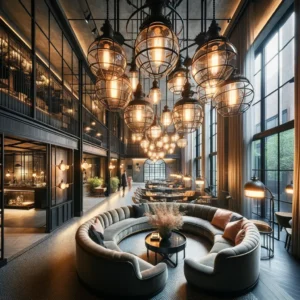
Each of these examples illustrates the versatility of industrial lighting and how it can be used to transform spaces. Through careful choices of style, material, and configuration, industrial lighting can enhance the aesthetics and functionality of any space, becoming an integral part of the design narrative.
How to Choose the Right Industrial Lighting
Choosing the right industrial lighting is a balancing act between aesthetics, functionality, and harmony with the existing space. Here are some essential considerations to make when selecting industrial lighting fixtures for any project.
A. Understand Space
Every space speaks a unique language, and lighting should complement its narrative. In a space with high ceilings and wide open spaces, large-scale fixtures can create a visual impact without overwhelming the space. Conversely, smaller spaces benefit from more understated fixtures that provide just enough light without overpowering the space.
B. Purpose of Enlightenment
Define the purpose of the lighting in the space. If it’s for task lighting, the light should be directed and bright enough to perform specific tasks. For ambient lighting, fixtures that provide a soft, diffused glow are ideal, adding warmth and atmosphere to the space without causing glare.
C. Consistency with Decorating Style
Industrial lighting should be an extension of the overall style of the space. If your interior is an urban loft with exposed brick and concrete, raw metal and glass fixtures will complement the look. For a space that blends industrial elements with modern decor, choose fixtures with clean lines and polished finishes.
D. Choose Color Temperature
Color temperature is measured in Kelvin and can range from warm to cool tones. Warmer light (2,700 to 3,000K) is inviting and relaxing, ideal for living rooms and restaurants. Cooler lights (4,000K and above) are energizing, suitable for workspaces and kitchens.
E. Light Intensity and Control
The ability to control light intensity is crucial. In a home setting, dimmers can adjust lighting to suit different activities or times of day. In commercial settings, lighting may need to be brighter and more consistent, especially in focal areas like service desks and display areas.
F. Technical and Safety Considerations
Before finalizing a lighting choice, it’s important to consider the technical and safety specifications. This includes understanding the electrical requirements, compatibility with existing power systems, and compliance with local building and safety codes.
G. Sustainability and Energy Efficiency
With a growing focus on sustainability, choosing lighting that is both efficient and durable is key. LED lighting fixtures, for example, not only consume less energy but also have a longer lifespan, making a conscious choice for both the environment and your budget in the long run.
By considering these considerations, you will be able to select industrial lighting that not only meets the functional needs of the space, but also enhances its beauty and contributes to creating a pleasant and inviting environment.
Impact of Industrial Lighting on Well-being
The impact of lighting on human well-being cannot be underestimated. Studies have shown that lighting not only affects our ability to see, but also directly influences our mood, energy and overall health. In the workplace, for example, inadequate lighting can result in eye strain, poor concentration and even a decrease in overall well-being. Industrial lighting, with its ability to provide ample and uniform illumination, can be an effective solution.
Conclusion
Industrial lighting has come a long way since its practical origins. Today, it is a powerful force in interior design, offering both functionality and a distinctive aesthetic that can complement and transform any space. This article has explored the many facets of industrial lighting, from its history and design to current trends and impact on wellbeing, providing the reader with an in-depth understanding of how this trend can be applied and adapted to suit their needs.
